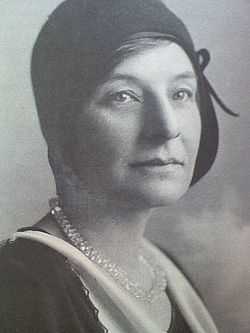Grace Stone Coates
| Grace Stone Coates | |
|---|---|
 |
Grace Stone Coates (1881–1976) wrote short stories, novels, poetry, and news articles. She spent most of her time writing out of her home in Martinsdale, Montana. Coates published her first poem, "The Intruder," in 1921 and her first novel, Black Cherries, in 1931. She co-edited and wrote for Frontier, a literary magazine edited by Harold G. Merriam, a creative writing professor at the University of Montana.
History
Early life
On May 20, 1881, Grace Genevieve Stone was born on a wheat farm in Kansas to Heinrich and Olive Stone. She was the youngest of four children. Grace and her older sister, Helen, were born to Heinrich and Olive. The two older children were born to Heinrich and his first wife. Heinrich had a rich classical background; he taught Greek in Berlin before coming to the United States. He channeled his love of the classics into his interactions with Grace, recited poetry to her, took her on long walks to learn the names of plants and trees, and read her mythology until she could recite it from memory. Her poetry was greatly influenced by her childhood and by her father.[1]
Her family moved to Wisconsin when she was in high school, where she attended Oshkosh State Normal School. Coates also attended the University of Chicago, the University of Southern California and the University of Hawaii. She never finished a degree, but received her teaching certificate in 1900.
Montana
Grace moved to Stevensville, Montana, to be closer to her sister Helen, and started teaching. She later moved to Butte, where she met her future husband, Henderson Coates. The two married in 1910 and moved to Martinsdale, where her husband opened a general store with his brother. Grace taught in Martinsdale from 1914–1919 and was the Meagher County Superintendent from 1918-1921. This is where she started writing. Her first poem, "The Intruder," was published in Poetry, a Magazine of Verse.[2]
In 1927 H.G. Merriam asked Coates to help him with a literary magazine, Frontier. She started writing articles and poems for the magazine and before long became the assistant editor. Merriam encouraged her to get her work published, helped her find publishers, and in 1931 she published two books; her first novel, Black Cherries, and her first book of poems, Mead & Mangel-Wurzel. Coates worked for the magazine out of Northwest Montana, until it stopped circulating in 1939. During the Great Depression, Coates helped write the WPA Federal Writers' Project Montana state guidebook.[3] Coates stopped writing seriously in the 1930s, but she continued to participate in her favorite form of writing through letters. After her death, her letters were collected and used to illustrate her life in a biography written by Lee Rostad.
Grace started losing a little bit of her mental capacity when her husband died. She began to see things that weren't there, such as intruders in her house, and was found wandering around outside in the middle of the night. She had a hard time remembering when and what she ate, and suffered from malnutrition. Her neighbors in Martinsdale got together in 1963 to move her to a retirement home in Bozeman. There, with a healthy diet and adequate rest, she was able to write a column for the Bozeman Daily Chronicle. The column was named Hillcrest Highlights, for the Hillcrest Retirement Home she was living in. Coates died in 1976, she was 95. According to her wishes, her body was cremated, and the ashes were scattered west of Martinsdale in one of the places she loved to walk.[4]
Work
In the 1920s and first part of the 1930s, Coates published well over a hundred poems and short stories. She edited for Caxton Press, Frontier, and wrote stories for local and Montana state papers. She published a novel and two books of poetry in the early 1930s. She wrote letters. Her writing drew inspiration from her childhood, her love of nature, her love for her husband Henderson, and bouts with depression. Coates stopped writing everything but letters in the late 1930s, only to start back up again when she moved to a Bozeman retirement home.[5]
Historian Lee Rostad knew Coates when she lived in Martinsdale and wanted to make sure Coates legacy wasn't forgotten. After Coates's death, she took it upon herself to collect as many letters and unpublished work as she could find and publish it in a biography, Honey Wine and Hunger Root, which was published in 1985. Rostad published two other books about Coates, one a collection of poetry, Food of Gods and Starvelings, and one a collection of letters and unpublished poems, Grace Stone Coates, Her Life in Letters.
Authored books
Black Cherries, published in 1931 by Alfred Knopf
Mead & Mangel-Wurzel, published in 1931 Caxton Printers Ltd. out of Caldwell, Idaho
Portulacas in the Wheat, her second book of poems, published in 1932
She co-authored Pat Tucker's book, Riding the High Country, published in 1933
Books about
Honey Wine and Hunger Root, Lee Rostad, 1985, Falcon Press, Helena/Billings, Montana
Food of Gods and Starvelings, the Selected Poems of Grace Stone Coates, edited by Lee Rostad and Rick Newby, 2007, Drumlummon Institute, Helena, Montana
Grace Stone Coates, Her Life in Letters, Lee Rostad, 2004, Riverbend Publishing, Helena, Montana
References
- ↑ Grace Stone Coates, Her Life in Letters, Rostad, Lee, 2004, Riverbend Publishing, Helena, Montana
- ↑ Grace Stone Coates Papers, K. Ross Toole Archives, The University of Montana-Missoula
- ↑ "Collection 34 - Grace Stone Coates Papers, 1933-1960". Montana State University Library. Retrieved July 26, 2011.
- ↑ Honey Wine and Hunger Root, Rostad, Lee, 1985, Falcon Press, Helena/Billings, Montana
- ↑ Food of Gods and Starvelings, The Selected Poems of Grace Stone Coates, 2007, Edited by Lee Rostad and Rick Newby,Drumlummon Institute, Helena, Montana
External links
|